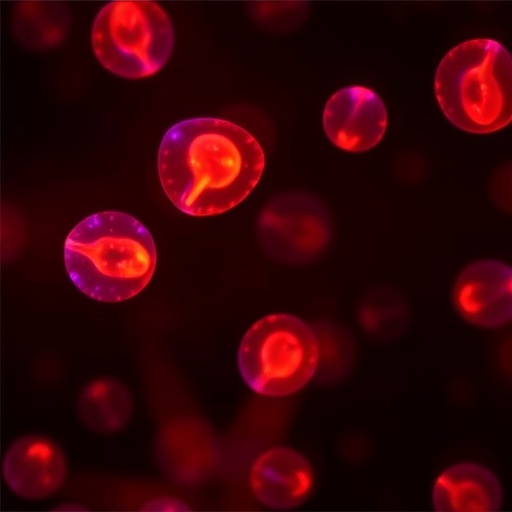Recent research published in the Journal of Ovarian Research has identified significant biological alterations in mouse oocytes due to superovulation, an extensive reproductive process used in various fields including commercial animal breeding and assisted reproductive technology. The study conducted by Tire, Talibova, Bilmez, and colleagues presents compelling evidence that excess stimulation of ovarian follicles not only affects the quantity of ova produced but also leads to critical changes in telomere length and the levels of telomerase components within these cells. This research lays important groundwork for understanding the long-term implications of superovulation on reproductive health and cellular aging.
Telomeres, the protective caps at the ends of chromosomes, play a pivotal role in cellular aging and stability. Every time a cell divides, telomeres shorten, which is associated with aging and increased susceptibility to cellular dysfunction. In the context of oocytes, maintaining telomere length is crucial as it directly correlates with the viability and developmental potential of ova. The experiment’s findings indicated that superovulation not only affects the length of these telomeres but may also disrupt the balance of critical telomerase components responsible for extending telomeres, thereby influencing the oocyte’s long-term health.
The researchers utilized a robust experimental design that involved subjecting female mice to superovulation protocols, which are characterized by the administration of gonadotropins that stimulate ovarian follicles to mature and release multiple eggs during a single estrus cycle. This intense hormonal manipulation is often necessary for maximizing egg retrieval efficiency but raises questions about the biological costs associated with such heightened reproductive efforts. The outcomes of this study prompt renewed discussions on the safety and efficacy of superovulation practices in both animal husbandry and clinical settings.
One of the most significant findings of the study was the correlation between superovulation and telomere shortening in oocytes. The authors meticulously measured telomere length using quantitative PCR methods, demonstrating a clear trend of reduction linked to the intensity of ovarian stimulation. This reduction in telomere length can have profound implications, as shortened telomeres may compromise the oocyte’s developmental capabilities and lead to lower fertilization rates, impacting fertility outcomes.
Furthermore, alterations in telomerase component levels were observed as a direct consequence of superovulation. Telomerase is an essential enzyme complex responsible for extending telomeres and maintaining chromosomal integrity. The study indicated that excessive superovulation can induce dysregulation of this complex, leading to diminished telomerase activity in oocytes. These findings underscore the intricate balance required to maintain oocyte health and the unforeseen consequences that can arise from overly aggressive reproductive strategies.
The implications of this research extend beyond immediate fertility concerns. Telomere length and telomerase activity are also associated with several age-related conditions, highlighting the potential for superovulation to contribute to broader health issues not just in the immediate reproductive context, but also in the long term. The alterations induced by superovulation may predispose offspring to aging-related diseases and could serve as a risk factor for future generations, sparking interest among geneticists and reproductive biologists alike.
This revelation raises imperative questions surrounding current practices in assisted reproduction and animal breeding. It invites further investigation into the ethical considerations and long-term ramifications of employing superovulation techniques without fully understanding their biological impacts. Should the protective mechanisms at the cellular level be compromised, the repercussions could extend far beyond mere reproductive success, affecting overall health and genetic integrity.
Moreover, the study emphasizes the need for additional research into potential strategies that may mitigate the adverse effects of superovulation. Possible solutions could range from optimizing hormonal protocols to respect the natural physiological limits of oocyte development, or even exploring alternative reproductive strategies that prioritize cellular health alongside reproductive outcomes.
As scientific communities strive to enhance reproductive technologies, the findings from Tire et al. serve as a cautionary tale. It is essential to balance the pursuit of efficiency in reproductive harvests with the fundamental biological principles governing cellular health and longevity. This approach can ensure the preservation of both individual oocyte function and the broader implications for species health in controlled breeding programs.
In summary, the work by Tire, Talibova, Bilmez, and their team represents a notable advancement in our understanding of reproductive biology, particularly in the context of superovulation. Their insights into the relationship between telomere dynamics and oocyte developmental capacity illuminate significant avenues for future research. Researchers are now more aware than ever of the delicate interplay between reproductive strategies and long-term biological consequences, paving the way for more sustainable practices in reproductive science.
These findings are likely to resonate widely among reproductive biologists, geneticists, and clinicians, prompting a critical reevaluation of superovulation’s role in both wildlife and agricultural practices. As we move towards a deeper understanding of cellular aging and fertility, studies like this will guide more informed approaches to reproduction, ultimately enhancing the health and viability of both animals and humans alike.
In conclusion, the study of how superovulation affects telomere length and telomerase levels in oocytes sheds light on the profound impact of reproductive technologies. As reproductive medicine continues to evolve, it is imperative that such findings influence future guidelines and methodologies, ensuring that the focus remains not only on immediate reproductive success but also on the long-term viability and health of future generations.
Subject of Research: Effects of superovulation on telomere length and telomerase levels in mouse oocytes.
Article Title: Superovulation alters telomere length and telomerase component levels in mouse oocytes.
Article References:
Tire, B., Talibova, G., Bilmez, Y. et al. Superovulation alters telomere length and telomerase component levels in mouse oocytes.
J Ovarian Res 18, 210 (2025). https://doi.org/10.1186/s13048-025-01735-x
Image Credits: AI Generated
DOI: 10.1186/s13048-025-01735-x
Keywords: Superovulation, telomere length, telomerase, oocytes, reproductive health, cellular aging, fertility.




